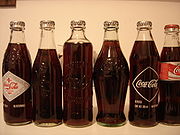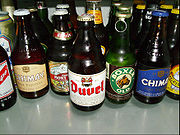
Glass Bottles
Encyclopedia


Bottle
A bottle is a rigid container with a neck that is narrower than the body and a "mouth". By contrast, a jar has a relatively large mouth or opening. Bottles are often made of glass, clay, plastic, aluminum or other impervious materials, and typically used to store liquids such as water, milk, soft...
created from glass
Glass
Glass is an amorphous solid material. Glasses are typically brittle and optically transparent.The most familiar type of glass, used for centuries in windows and drinking vessels, is soda-lime glass, composed of about 75% silica plus Na2O, CaO, and several minor additives...
. Glass bottles can vary in size considerably, but are most commonly found in sizes ranging between about 10ml and 5 liter
Litér
- External links :*...
s.
The history of glass can be traced back to at least 12,000 BC
Anno Domini
and Before Christ are designations used to label or number years used with the Julian and Gregorian calendars....
where glass coated objects have been found.
Millions of glass bottles are created worldwide every day. In the US, there is an average of at least two bottle-making factories in each county. It is a highly mechanized process, and the bottles in use now are no longer hand blown as they were in the past.
A glass bottle is 100% recyclable with many new bottles containing glass which was created over 20 years ago. Less energy is used in recycling a glass bottle than creating the glass from raw materials, helping the environment.
When glass bottles of liquid are dropped or subjected to shock, the water hammer
Water hammer
Water hammer is a pressure surge or wave resulting when a fluid in motion is forced to stop or change direction suddenly . Water hammer commonly occurs when a valve is closed suddenly at an end of a pipeline system, and a pressure wave propagates in the pipe...
effect may cause hydrodynamic glass breakage.
Glass bottles manufacturing takes place over several stages. To briefly outline the processes from beginning to end: raw material, melting, forming, annealing, physical inspection, machine & laser inspection, physical inspection (second time), quality control, and finally packing.
To strengthen glass bottles, the process of lamination is sometimes done. Laminated safety glass is made by combining a layer of plastic over glass. When a non-laminated bottle is dropped, the glass breaks sending pieces of glass everywhere. When a laminated bottle is dropped, the glass still breaks, though the outer layer of plastic contains the broken pieces of glass.
Once formation is complete, some bottles may suffer from stress as a result of unequal cooling rates. An annealing oven can be used to reheat and cool glass containers to rectify stress and make the bottle stronger.
Books, general references
- Soroka, W, "Fundamentals of Packaging Technology", IoPP, 2002, ISBN 1-930268-25-4
- Yam, K. L., "Encyclopedia of Packaging Technology", John Wiley & Sons, 2009, ISBN 978-0-470-08704-6

